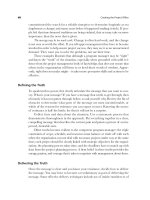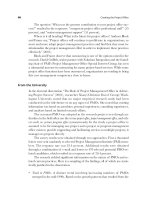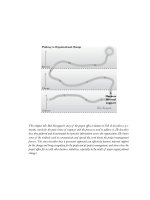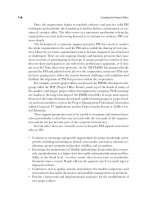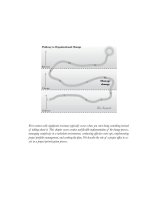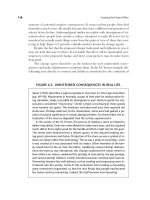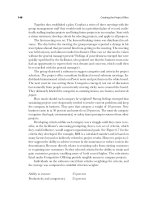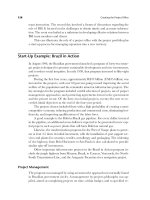Tài liệu Creating the project office 31 doc
Bạn đang xem bản rút gọn của tài liệu. Xem và tải ngay bản đầy đủ của tài liệu tại đây (133.08 KB, 10 trang )
HR or Training department that insists on reducing project management train-
ing to a brown bag “lunch and learn” session, or the Finance department that will
not change antiquated accounting procedures. And do not lose hope. Even if all
you can do are little things, little things add up.
Reaching for the “Tipping Point”
Malcolm Gladwell (2002) writes about that “magic moment when an idea, trend,
or social behavior crosses a threshold, tips, and spreads like wildfire” (back cover).
Small changes can make a big difference, just as in chaos theory when small initial
conditions can have enormous consequences, however unpredictable.
The ebb and flow or transformation of unknowns into widespread applica-
tions may be thought of as resembling epidemics. “Ideas and products and mes-
sages and behaviors spread just like viruses do....Epidemics are a function of
the people who transmit infectious agents, the infectious agent itself, and the en-
vironment in which the infectious agent is operating” (p. 18). The three agents of
change, according to Gladwell, are the Law of the Few, the Stickiness Factor, and
the Power of Context. We call these the people, the process, and the environment.
People. “In a given process or system some people matter more than others . . .
a tiny percentage of people do the majority of the work....Social epidemics are
driven by the efforts of a handful of exceptional people” who have social con-
nections, energy, enthusiasm, and personality (pp. 19-21). Gladwell calls them
Connectors—people with a special gift for bringing the world together, of mak-
ing friends and acquaintances; Mavens—people who accumulate knowledge and
want to tell others about it; and Salesmen—people who persuade others not only
with words but through movement and speech as well.
278 Creating the Project Office
Establish sense of
urgency— clear danger
• reach the tipping point
• invoke agents of change:
people, process, environment
• focus on core
• act organically
• use templates
Leading
Organizational
Change
to PBO
Create guiding coalition—
powerful forces
Develop vision and
strategy—focus
Manage the change—
short-term wins, broad-based
action, consolidate gains
Develop broad-based action—
keep moving, implementing
Staff and operate—
In or out?
Make change stick—
new PBO culture
The tale we tell
Communicate the change
vision—tell the tale
Process. Some epidemics tip because the message or the agent has changed in
a way that makes it more contagious. The question is “how to make messages
more contagious?” (p. 20). The Stickiness Factor says small but critical adjustments
in the presentation and structuring of information can make a big difference in
how much of an impact the message makes. “There is a simple way to package
information that, under the right circumstances, can make it irresistible. All you
have to do is find it” (p.132).
Environment. “The key to getting people to change their behavior . . . sometimes
lies with the smallest details of their immediate situation. The Power of Context says
that human beings are a lot more sensitive to their environment than they may seem”
(p. 29). “Epidemics are sensitive to the conditions and circumstances of the times and
places in which they occur” (p. 139). They “can be reversed, can be tipped, by tinker-
ing with the smallest details of the immediate environment” (p. 146).
Studies show the impact of the Law of the Few and the Power of Context can
be enormous: our “inner states—preferences and emotions—are actually power-
fully and imperceptibly influenced by seemingly inconsequential personal influ-
ences [and] our inner states are the result of our outer circumstances” (p. 152).
“We are a lot more attuned to personal cues than contextual cues” (p. 162). Con-
text does matter, however, and environmental tipping points are things we can more
easily change.
Gladwell would doubtless concur with the basic premises we propose in Chap-
ter Ten. He writes, “If you want to bring about a fundamental change in people’s
belief and behavior, a change that would persist and serve as an example to oth-
ers, you need to create a community around them, where those new beliefs could
be practiced and expressed and nurtured....Small close-knit groups have the
power to magnify the epidemic potential of a message or idea” (pp. 173–174).
He summarizes by saying that Contagiousness is a function of the messenger
while Stickiness is primarily a property of the message. A successful change agent
has changed the context of the message, changed the messenger, changed the mes-
sage itself, and focused the change efforts. Starting epidemics requires:
• Concentrating resources on a few key areas
• Conducting tightly focused, targeted interventions
• Solving problems with the minimum amount of effort and time and cost
• Reframing the way we think about the world
• Believing that change is possible, that people can radically transform their be-
havior or beliefs in the face of the right kind of impetus
• Knowing it is the nature of people and events to be volatile and inexplicable
• Reaffirming the power of intelligent action
The Tale We Tell 279
On the other hand. Epidemics grind to a halt when people develop an immunity
to the infectious agent. Too much e-mail, too many telemarketing calls and people
turn away from the message or the technology. “When people are overwhelmed
with information and develop immunity to traditional forms of communications,
they turn instead for advice and information to the people in their lives whom they
respect, admire, and trust. The cure for immunity is finding Mavens, Connectors,
and Salesmen” (p. 175). We come to increasingly value face-to-face communica-
tions and word of mouth.
These factors help to explain why the players in the case studies described in
this book are so successful. They connect with the right people and create guid-
ing coalitions; they develop streamlined methodologies (processes) and package
them to fit the needs of the people and the organization; and they unceasingly
work the environment through constant and thorough communications and
coaching. There is no one right way to do all this. Both Gladwell’s and our case
studies show it takes continuous experimentation, sometimes with many little
things, to find the combination that works. Perseverance combined with focused
efforts on people, process, and environment is what it takes.
Focus on Your Core
Management consultant Geoffrey Moore, in Living on the Fault Line (2000), says the
new resource scarcity in managing for shareholder value is time, talent, and man-
agement attention. Old systems of saving money (cost) are out of synch with a new
world that wants us to save a lot of time. He believes too much time is being spent
on tasks that are context, too little on tasks that are core. He passionately argues that
“Any behavior that can raise your stock price is core—everything else is context” (p. 27). Core
tasks differentiate companies in their targeted markets. Context tasks certainly add
value but do not contribute to competitive advantage. He recommends outsourcing
as distancing the company from context, and “doing it can raise your stock price
because it communicates to investors that you are putting your time, your talent,
and your management attention to work on core issues” (p. 39).
These issues can help position a project office. One role is to take over con-
text tasks so other people can focus on core tasks, much as Bucero did with HP
Consulting. Another role is to take on management of outsourcing, which creates
a double benefit. Context tasks are shifted outside the organization, and scarce
management attention does not have to spend much time on the outsourcing re-
lationship because the PO takes care of it. An even more powerful role, the strate-
gic project office, greatly facilitates the selection process and execution of core
tasks that lead to competitive advantage.
280 Creating the Project Office
Another way to position a project office is to set it up jointly with the cus-
tomer. Debra Henrichs of HP’s global program management office did this with
a large insurance company. The joint office reinforced the intercompany part-
nership and gave HP greater insights into the customer environment. It was use-
ful to both companies to have a consultative situation for project management,
and HP management recognized that their success often depends on customer
success. Working sessions whose purpose was to identify project relationships and
responsibilities surfaced issues such as these:
• Too many sponsors
• Overlapping resource needs
• Dependencies known but not documented
• Priority-driven requirements and changes were lacking
Joint project office successes included a change control process that turned
into a key communication device. The cooperation provided visibility into the
“real” project and customer issues and made the escalation path clear. It had a
positive impact on financial services performance, allowed customer executives to
leverage the experience in a reorganization, and eventually turned it its final de-
liverables two weeks early. HP and the customer shared project management and
software development best practices, and both sides profited. When it comes to
increasing the customer and end-user success factor and to focusing on core is-
sues, the joint project office concept is a winner.
Making It Work
We offer a few more obstacles and suggestions for making change stick that might
help answer frequently asked questions:
1. A PO was originally aimed at resolving the issues of a specific department.
Before implementation, the scope was broadened to include an entire organiza-
tion. This set off a political feud early on. Proposed solution: Clarify matters in an exec-
utive briefing to top management, in an introductory talk to a larger audience and through
one-on-one coaching. Also the PMO should try to meet the needs of all stakeholders.
2. During the development of a PO, the internal client’s expectation of the
PO was slanted toward a technological, methodological, software-type solution—
a black box that would resolve the ills of project management in the company. The
head of the new PO, who was supported by an outside consulting company, was
faced with the issue of convincing upper management and other stakeholders that
basic PM concepts, training, and processes are necessary before implementing
The Tale We Tell 281
tools. Proposed solution: Use literature and opinions from outside experts to influence stakehold-
ers. Also hold workshops in which the basic issues of project management are discussed.
3. Ten months of work by outside consultants were spent developing proce-
dures for a PMO in the IT department of a telecommunications carrier. Due to a
budget cutback, the implementation stage of the project was canceled. Subse-
quently, there was a downturn in the market and the IT group was downsized
substantially. Proposed solution: Wait for better times.
4. I am a project manager and the organization that I work for does not have
a project office nor intend to establish one. What is it that I can do within my or-
ganization? Proposed solution: Become a Project Office of One. Individuals can embody all the
traits, skills, and knowledge that we cover in this book. Individuals learning to unfreeze, change,
and refreeze the people around them offer tremendous value.
Organic Metaphors
The California-based authors especially enjoy the beauty of the state’s giant red-
wood forests, containing some of the tallest and oldest trees on the Pacific coast.
The redwood forest, through its root system, is completely interconnected. An in-
teresting thing about redwoods is that they have very shallow roots which make it
difficult for them to survive. Growing along the coastal fog belt in California and
up into southern Oregon, they need the fog to get through dry summers. Shaded
canyons also supply water for their very shallow roots. The root system goes out
as far as a mile; the roots interlock and grow together in a way that allows those
trees closer to the water source to send roots up the hillside and supply water to
trees that are further away. The trees depend upon active teamwork for survival.
Effective teamwork on projects also needs a solid base of interlocking roots.
The project office is a primal means to provide systemic interconnectivity.
Many projects may not survive on their own but are important as part of the or-
ganization’s ability to offer a total solution to customers. An important role for the
project office is to deliver sustenance across the organization—information, mo-
tivation, and resources—so that team members and management alike do the
right projects and do projects right.
A fruit tree is a powerful metaphor for organizational dynamics. Peter Senge
and Daniel Kim (The Systems Thinker, Pegasus Communications, May 1997) de-
scribe The Cycle of Knowledge-Creation: “Like theories, the tree’s roots are invisible,
and yet the health of the root system determines the health of the tree. The
branches are the methods and tools, which enable translation of theories into new
capabilities and practical results. The fruit is that practical knowledge. The tree
as a whole is a system.”
282 Creating the Project Office
